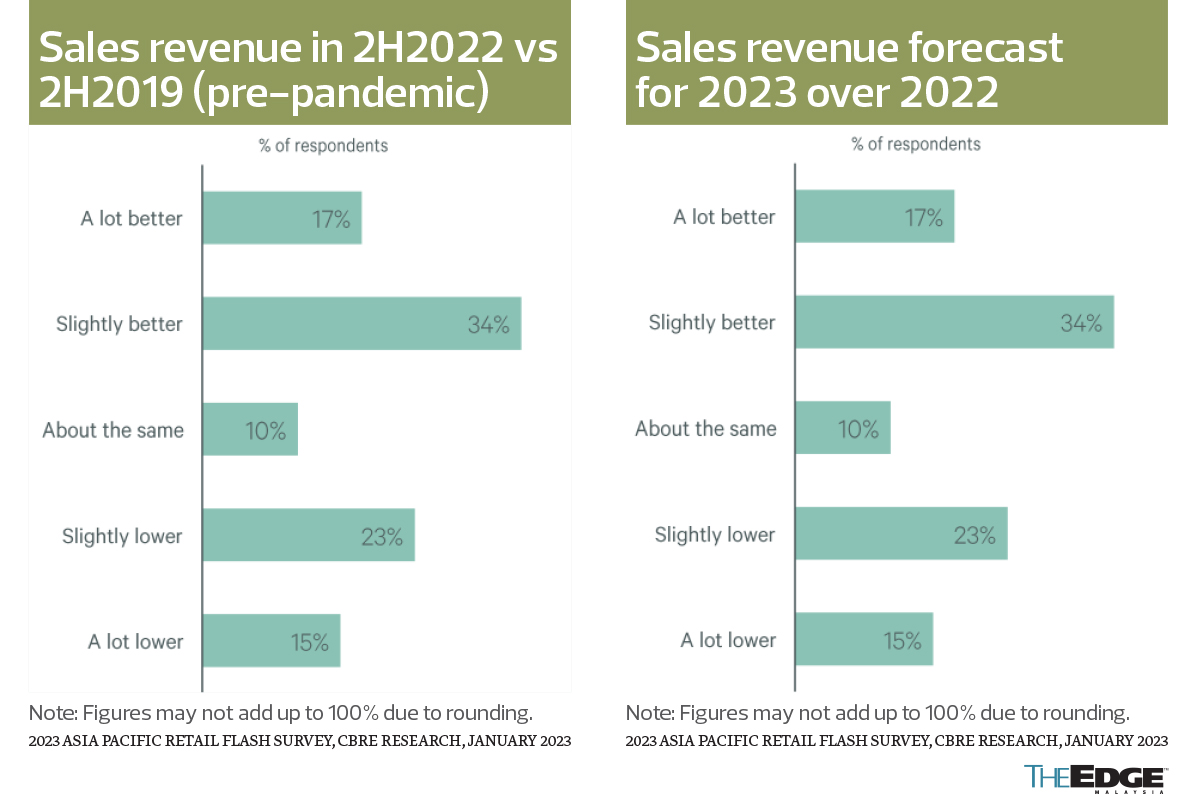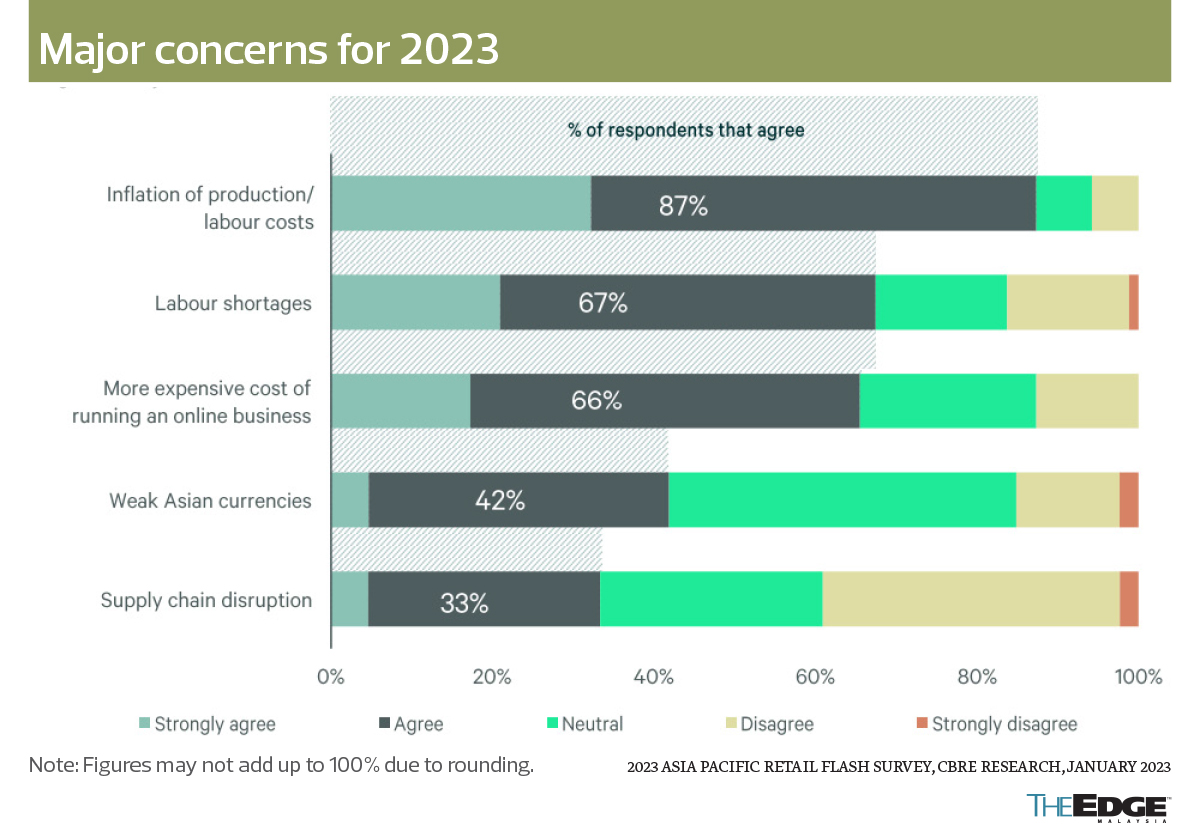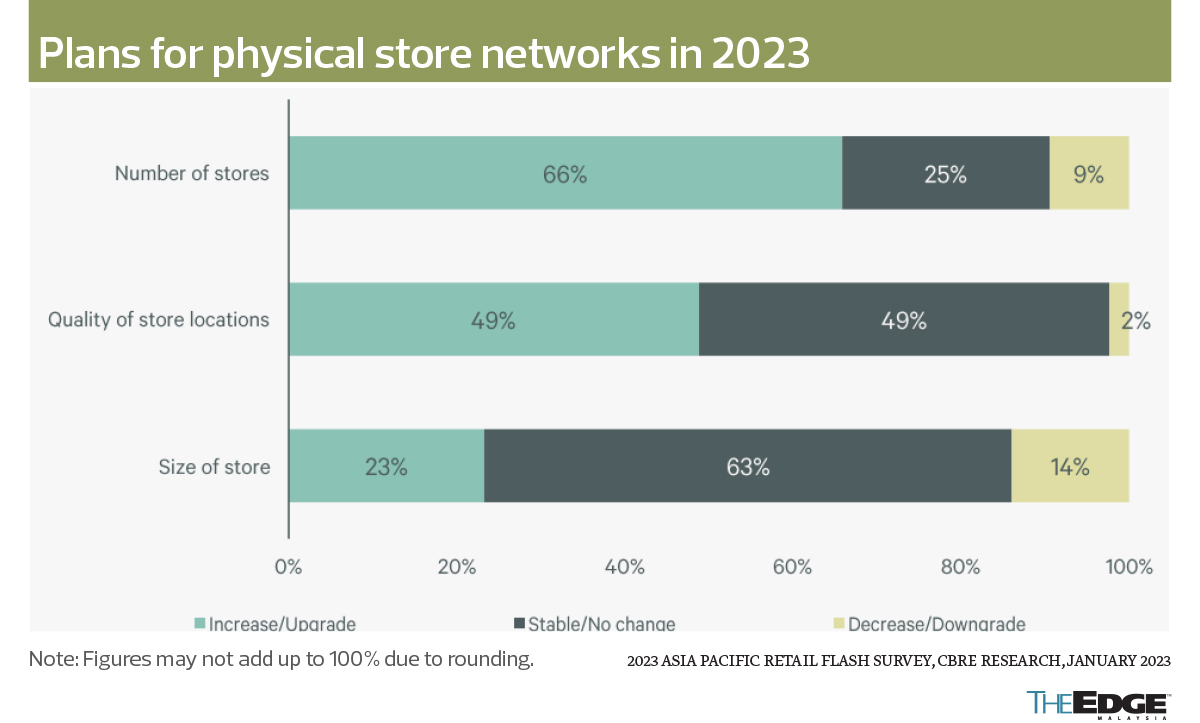
Most merchants expect operational costs to continue to rise, with major concerns being, among others, inflation of production or labour costs and supply chain disruptions (Photo by Kenny Yap/The Edge)
This article first appeared in City & Country, The Edge Malaysia Weekly on February 6, 2023 - February 12, 2023
The Asia-Pacific retail sector is on track to recovery this year, with most retailers expecting more sales while planning to open new stores, according to the January 2023 CBRE Research Asia-Pacific Retail Flash Survey report.
The survey was conducted from November to December 2022, with a total of 87 responses from retailers across Asia-Pacific. Thirty per cent of the respondents were from Greater China, 29% from Southeast Asia, 22% from Australia and New Zealand and 19% from other parts of Asia-Pacific.
Asia-Pacific’s retail sector recovery continued to gain momentum in 2022, with half of the respondents stating that sales in 2H2022 surpassed pre-pandemic levels, the report says. However, most mainland Chinese respondents felt the opposite due to pandemic curbs, which remained in force during the survey.
Optimism despite rising costs
According to the survey, 72% of retailers are expecting their sales performance to improve moderately this year despite 87% believing business operating costs will continue to rise. “Optimism in most markets is being driven by the rebound in international tourism across the region. However, with rapid rate hikes and economic volatility having dented confidence in recent months, consumers are set to adopt a more cautious attitude towards spending on big-ticket items,” the report says.
While e-commerce is undoubtedly here to stay, CBRE finds that shoppers are now returning to bricks-and-mortar stores in greater numbers as many countries have transitioned to the endemic phase. Similarly, half of the respondents anticipate that a portion of online sales will return to bricks-and-mortar retail.
Although retailers are divided on whether footfall would return to pre-pandemic levels, CBRE believes retail foot traffic will improve further now that mainland China has moved past its zero-Covid strategy. The report notes that this move occurred after the survey was conducted.
With more employees returning to the office, there has been an increase in footfall in central business district (CBD) areas — a trend observed across Asia, the report adds. The survey shows 68% of the respondents agreed that the return to the office will benefit CBD retail, while 48% said some online purchasers will shift back to buying from physical retail stores. Meanwhile, most merchants expect operational costs to continue to rise. Their major concerns this year include inflation of production or labour costs (87%), labour shortages (67%), higher cost of running an online business (66%), weak Asian currencies (42%) and supply chain disruptions (33%).
The report lists several factors leading to such concerns. “Low unemployment will push up wage growth and production costs. For online retailers, the rising expense of new customer acquisition and logistics will erode margins.”
Nonetheless, macroeconomic issues such as currency fluctuation and supply chain disruption ranked relatively low among the list of main concerns because the economy is set to improve this year, it adds.
Plans for expansion
According to the report, 71% of retailers are planning to expand or add new stores while 15% are intending to right-size and 14% wish to remain the same in 2023. It notes the strong expansionary sentiment among retailers since mid-2022 as tracked in the CBRE Asia-Pacific Leasing Market Sentiment Survey conducted in December last year.
Meanwhile, the current survey uncovered a distinct variation in sentiment across different retail categories. “Expansionary sentiment is being driven by the general fashion, entertainment and other service trades, which were hit hard by pandemic restrictions and/or consolidated store networks over the past two years.
“In contrast, sporting goods and F&B retailers are planning to consolidate after expanding aggressively in recent years,” the report states.
According to CBRE, expansions will remain conservative in 2023 as retailers seek to manage recession and inflation risks. Most respondents stated a preference for existing markets, with only one-third planning to enter a new location.
“Upgrading store networks (and in the process, capitalising on lower rents) is another key priority.
“Other areas of focus include lease renegotiation or restructuring amid growing demand for the inclusion and expansion of force majeure clauses after the pandemic, and a shift to a turnover rent model amid what is still a tenant-favoured market,” the report adds.
Relocation, consolidation and downsizing were among the lowest priorities.
Retailers are still cautious about expanding their overseas footprint, with only 30% of respondents seeking cross-border expansion this year, well below the 50% recorded in the 2021 survey.
The report notes that mainland China ranks as the top destination for cross-border expansion due to government stimulus and domestic consumption. Hong Kong SAR and Singapore trail behind as joint second favourites thanks to government stimulus, domestic consumption and the return of tourists.
Ranked joint fourth in top destinations for cross-border expansion were Malaysia, Vietnam, Taiwan and Japan. CBRE believes the Southeast Asian countries, Japan, Australia and New Zealand will benefit from the ongoing tourism recovery, with the imminent return of mainland Chinese tourists set to provide a major boost. Japan is also a beneficiary of currency depreciation while Taiwan receives government stimulus.
Demand for retail spaces
This year, CBRE anticipates a solid appetite for more and better retail spaces.
“New set-ups and expansion will become more prominent in 2023, strengthening their status as the major drivers of leasing demand. Compared with 2021’s survey, fewer retailers intend to trade down in terms of store location or shop size.
“While most F&B retailers are planning to open standalone shops, non-F&B traders are displaying a stronger preference for flagship stores and pop-ups,” the report asserts.
Sixty-six per cent of the respondents foresee that the number of retail stores will increase or be upgraded. Respondents were equally divided over the quality of store locations, with half saying there will be an upgrade and the other half saying there will be no changes.
Meanwhile, 63% of the respondents think store sizes will remain the same with few changes, compared to 23% who believe in upgrades and the remaining 14% in downgrades.
The report further notes, “Strong flight- to-quality demand continues to prompt retailers to seek high-quality retail spaces in city centres and along prime high streets. While decentralised properties will also continue to attract interest, CBRE expects assets in prime locations to outperform in 2023.”
Shopping malls in city centres remained the most preferred location for new physical stores for 61% of the respondents, as compared with 52% in 2021. Prime high streets came in second with 47% but lower than its 2021 preference, which was at 48%. Decentralised neighbourhoods and community malls were the third-best preferred location with 44% this year compared with 36% in 2021.
“Secondary high streets in city centres logged the strongest uptick in retailers’ interest in this year’s survey”, registering 37% as compared with 23% in 2021. “As vacant units in prime locations are gradually absorbed and rents stabilise, some especially cost-sensitive retailers may seek opportunities to add new stores in secondary locations,” the report says.
Twenty-eight per cent of the respondents chose transit hubs like metro and railway stations as their preferred location, outlets (warehouses or stores that are opened by the manufacturer near the factory) witnessed a four per centage point drop to 18% (from 22%) while 17% preferred non-traditional retail such as revitalised buildings.
Although the survey foresees an increase in retail spaces, retailers may also face slow retail expansion due to the rising cost of store fit-outs. “Nearly 60% of respondents stated that fit-out costs had risen by 10% from pre-pandemic levels.
“With the retail market yet to fully recover, most retailers are asking landlords to provide more incentives or other contributions to offset growing fit-out costs,” the report highlights.
Based on the survey results, most retailers (79%) have asked landlords for longer rent-free or fit-out periods. Thirty-one per cent requested their landlords to pay for store improvements while 28% want to maintain existing budgets but use cheaper furniture and materials.
Retail strategies
For 2023, CBRE advises retailers to pursue expansion cautiously, focusing on markets where they already have a presence, and prioritise leases in shopping centres that have been performing well with a proven track record. The report recommends priority be given to flight-to-core locations where rents are still below pre-pandemic levels.
Apart from that, CBRE recommends retailers target markets with rebound potential. Mainland China and Hong Kong SAR are tipped to enjoy the strongest sales rebound after finally lifting pandemic-related policies. Other prospective destinations include Japan and Southeast Asia, which are expected to benefit from the recovery of leisure travel.
To reduce spending, retailers are urged to ensure their operating costs are kept under control. CBRE expects operating costs to escalate further, but at a slower pace. For example, retail rents will return to growth, with the strongest rental rebound expected in Hong Kong SAR, the report adds.
Lastly, CBRE encourages retailers to coax landlords into being more accommodating on rent-free periods and fit-out incentives to partially mitigate higher fit-out costs.
Save by subscribing to us for your print and/or digital copy.
P/S: The Edge is also available on Apple's App Store and Android's Google Play.
- World Economic Forum highlights EPF as model for sustainable retirement reform
- Li Ka-shing's CK Hutchison mulls global telco assets spin-off, eyes London listing, Reuters reports
- U Mobile secures MCMC award, gears up for nationwide 5G roll-out
- Indonesians feeling market gloom ahead of major holiday
- Seeking opportunities in a risk-off market
- Trump pressing advisers for tariff escalation ahead of April 2, Washington Post reports
- Myanmar's quake toll passes 1,000 as extent of devastation emerges
- MetMalaysia can issue quake warnings within eight minutes, says DG
- Li Ka-shing's CK Hutchison mulls global telco assets spin-off, eyes London listing, Reuters reports
- Vance accuses Denmark of not keeping Greenland safe from Russia, China




